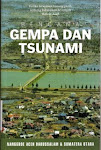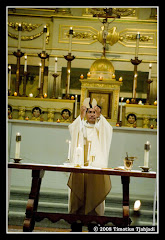sumber dokumentasi:
www.priesthood.motime.com
www.catholicradiodramas.com/SaintsPicturesJth...
www.abcgallery.com
Hidup Kudus di Dunia yang Dirusak Dosa
Saat beranjak dewasa, saya masih mengingat kisah ‘Daud melawan Goliath’ dan ‘Samson melawan Orang Filistin’ dari komik kitab suci yang pernah say abaca saat masih kecil. Kisah “Anak yang hilang” merupakan kisah yang selalu dinanti umat setiap kali romo berkunjung ke desa kami untuk ekaristi. Anak-anak sampai lansia menunggu dengan sabar romo itu menggambarkan anak hilang yang ingin mengenyangkan perutnya dengan makanan babi. Saya tak pernah lupa pada kisah misdinar kecil yang menyimpan hosti dalam mulutnya dan mempertahankannya sampai nafas terakhirnya. Ia termasuk dalam deretan santo-santa ‘abg’ (anak baru gedhe) dalam Gereja Katolik.
www.priesthood.motime.com
www.catholicradiodramas.com/SaintsPicturesJth...
www.abcgallery.com
Hidup Kudus di Dunia yang Dirusak Dosa
Saat beranjak dewasa, saya masih mengingat kisah ‘Daud melawan Goliath’ dan ‘Samson melawan Orang Filistin’ dari komik kitab suci yang pernah say abaca saat masih kecil. Kisah “Anak yang hilang” merupakan kisah yang selalu dinanti umat setiap kali romo berkunjung ke desa kami untuk ekaristi. Anak-anak sampai lansia menunggu dengan sabar romo itu menggambarkan anak hilang yang ingin mengenyangkan perutnya dengan makanan babi. Saya tak pernah lupa pada kisah misdinar kecil yang menyimpan hosti dalam mulutnya dan mempertahankannya sampai nafas terakhirnya. Ia termasuk dalam deretan santo-santa ‘abg’ (anak baru gedhe) dalam Gereja Katolik.
Sore ini kalian meminta saya berbicara mengenai hidup para kudus. Seberapa penting mencantumkan nama para kudus saat menerima sakramen baptis? Apakah keharusan menambahkan nama orang kudus saat menerima sakramen krisma? Kebanyakan pertanyaan kita mengenai hidup para kudus adalah praktis. Namun, jawaban terhadap pertanyaan-pertanyaan itu sayangnya harus memasuki wilayah ‘teologi.’ Saya berharap jawaban ini tidak mengerutkan dahi Anda. Saya berjanji diskusi ini tidak akan seberat yang Anda semua bayangkan. Mari kita mulai Faith Sharing Group sore ini bukan dengan hidup para kudus, tetapi hidup Anda sendiri.
Ambillah secarik kertas dan alat tulis. Catatlah beberapa orang yang Anda tahu masuk kategori pribadi baik dalam hidup Anda. Saya mengusulkan Anda tidak terlalu jauh mengambil contoh pribadi-pribadi itu. Ambillah pribadi-pribadi terdekat dalam hidup Anda sekarang ini. Lebih ideal lagi, kalau Anda berkenan mengambil pribadi-pribadi yang saat ini hadir dalam FSG malam ini. Ingatlah satu atau dua pengalaman hidup yang menarik yang pernah anda alami dengan pribadi itu. Bayangkanlah Anda harus mengisahkan hidup pribadi itu kepada orang lain. Ambil cukup waktu untuk mengisahkan kembali hidup orang itu kepada pribadi yang nanti akan ada disamping kanan dan kiri Anda saat FSG. Cobalah masuk ke sisi dalam pribadi itu jangan Cuma bungkusnya. Kemudian tariklah beberapa kualitas pribadi itu yang menurut pandangan Anda distinctive.
Aktivitas kedua barangkali lebih membuat Anda bekerja keras. Saya memohon Anda untuk mengingat santo-santa pelindung Anda. Seperti aktivitas pertama, lihatlah hidup santo-santa pelindung itu. Jangan malu-malu untuk browsing Internet kalau pengetahuan Anda mengenai pribadi itu hampir-hampir mendekati nol. Carilah sisi hidup dari pribadi itu yang paling menyentuh hidup Anda. Atau sisi hidup pribadi itu juga ada dalam diri Anda. Sama dengan aktivitas pertama, tariklah beberapa kualitas pribadi dari santo-santa pelindung ada yang menurut pandangan Anda distinctive. Apakah ada kualitas hidup mereka yang pantas diperkenalkan kepada generasi sekarang?
Saya berharap bagian terakhir ini tidak sampai membuat dahi Anda berkenyit. Bagian ini lumayan meminta konsentrasi karena menjadi pokok pembicaraan saya. Pembicaraan mengenai orang kudus tidak dapat dilepaskan dari pengalaman Gereja akan Allah yang senantiasa mencurahkan rahmat-Nya. Gereja sendiri menyebut diri sebagai Gereja yang kudus. Orang-orang kudus menyatakan secara konkret kekudusan Gereja sepanjang zaman. Mereka menjadi model bagi umat kristinai bahwa cara hidup kreatif mereka itu sungguh kristiani. Kira-kira begitu deh singkatnya.
165. In what way is the Church holy?
823-829
867
The Church is holy insofar as the Most Holy God is her author. Christ has given himself for her to sanctify her and make her a source of sanctification. The Holy Spirit gives her life with charity. In the Church one finds the fullness of the means of salvation. Holiness is the vocation of each of her members and the purpose of all her activities. The Church counts among her members the Virgin Mary and numerous Saints who are her models and intercessors. The holiness of the Church is the fountain of sanctification for her children who here on earth recognize themselves as sinners ever in need of conversion and purification.
Berikut ini ada dokumen resmi dari kantor Vatikan yang terlibat dengan proses beatifikasi - kanonisasi
New Procedures in the Rite of Beatification
Cardinal José Saraiva Martins, C.M.F.
Prefect of the Congregation for the Causes of Saints
--------------------------------------------------------------------------------
Everything is Directed Towards 'Holiness'
Throughout her history, the Church has always celebrated holiness as an expression of the "wonderful things" the Lord works in the life of his People. In response to sensibilities and historical contexts, the Church has paid special attention to the liturgical forms and procedures in which praise to the Most High is expressed and new life given to the faith and piety of the faithful.
These procedures and the significant wealth of such rites have also been carefully studied by the Church in light of the most recent ecclesial knowledge for a more incisive understanding and a more cogent effect of the very nature of holiness, which the Church celebrates with the rites of Beatification and Canonization.
To this end, the Holy Father Benedict XVI has introduced important new procedures for Beatifications.
I. Historical-juridical premise
1. In the first millennium of the Church's existence, the cult of Martyrs and later of Confessors of the Faith was regulated by the various particular Churches. On the occasion of a Synod, the Bishops, individually or collegially, would authorize new particular cults that began with the elevatio or translatio corporis [the body was exhumed and transferred]. These acts subsequently became known as "episcopal canonizations" or "particular canonizations" because they involved directly only the local Church (Benedict XIV, "Magister" of the Causes of Saints, will make episcopal canonization equivalent to beatification, which consists in the concession [permissio] of a cult "pro aliquibus determinatis locis". [De Servorum Dei beatificatione et beatorum canonizatione, Prato, 1839, L.I, ch. 31, 4, p. 196]).
In the 11th century, the principle that as universal Pastor of the Church the Roman Pontiff alone has the authority to prescribe a public devotion began to gain ground, both in the particular Churches and the universal Church. With a Letter to the King and Bishops of Sweden, Alexander III asserted the Pope's authority to confer the title of Saint and the relevant public cult. This norm became a universal law with Gregory IX in 1234.
In the 14th century, the Holy See began to authorize cults limited to specific places and to certain Servants of God whose canonization cause had not yet been initiated or had not yet reached its conclusion. This concession, with a view to future Canonization, is at the origin of Beatification.
After Sixtus IV (1483), Servants of God to whom a limited cult was granted were known as Blesseds. A definitive juridical distinction was thereby made between the titles of Saint and Blessed, which in the Middle Ages had been used loosely.
The concession of a local devotion was rendered official and communicated to those concerned in an Apostolic Letter in the form of a Brief, which the local Bishop implemented auctoritate apostolica.
After the establishment of the Congregation for Rites (1588) by Sixtus V, the Pope continued to permit limited cults (Missa et Officium) to culminate in Canonization. Procedures were gradually clarified and refined until they developed into the norms in force today which were promulgated in 1983.
2. The teaching on the institution of Beatification ("Doctores... tradunt Beatificationem esse actum, quo Summus Romanus Pontifex indulgendo permittit aliquem Dei Servum coli posse in aliqua Provincia, Dioecesi Civitate, aut Religiosa Familia Cultu quodam determinato, ac Beatorum proprio, usquequo ad solemnem eius Canonizationem deveniatur" [Benedictus XIV, L.I, ch. 39, 5, p. 262]), and Canonization (ibid., p. 263) has remained substantially unchanged down the centuries. The distinction between them (I. Noval, Commentarium Codicis Juris Canonici, Lib. IV De Processibus, pars II, Augustae Taurinorum Romae, 1932, p. 7), which is adequately expressed in the respective proclamatory or constitutive formulas, is clear and essential.
Canonization is the supreme glorification by the Church of a Servant of God raised to the honours of the altar with a decree declared definitive and preceptive for the whole Church, involving the solemn Magisterium of the Roman Pontiff.
This is expressed unequivocally in the formula: "Ad honorem Sanctae et Individuae Trinitatis... auctoritate Domini Nostri Jesu Christi, beatorum Apostolorum Petri et Pauli ac Nostra... Beatum N. N. Sanctum esse decernimus ac definimus, ac Sanctorum Catalogo adscribimus, statuentes eum in universa Ecclesia inter Sanctos pia devotione recoli debere".
Beatification, on the other hand, consists in the concession of a public cult in the form of an indult and limited to a Servant of God whose virtues to a heroic degree, or Martyrdom, have been duly recognized, as is pointed out by the respective formula: "...facultatem facimus ut Venerabilis Servus Dei N. N. Beati nomine in posterum appelletur, eiusque festum... in locis ac modis iure statutis quotannis celebrari possit".
II. The rites of Beatification down the centuries
The rites and ceremonies for Beatification and Canonization, as well as the formulas to be pronounced and other minor details, have been expressed in different ways, although they have essentially remained in doctrinal continuity. Here we point out four stages that solely concern the institution of Beatification:
a) Before 1662: The Pope, conceding a local cult (beatification), normally left to those concerned (Promoters of the Cause, the Local Ordinary) the possibility of choosing the day, venue and form in which to solemnize the event of the Beatification that had occurred and to inaugurate the new cult (Missa et Officium).
It could also happen in certain monasteries that no external solemnity was celebrated on the occasion of Beatification, but the feast of the new Blessed was commemorated on the day of the year established by the liturgical calendar.
b) From 1662 to 1968: The first Beatification in solemn form was that of St. Francis de Sales, desired by Alexander VII. The rite took place in St. Peter's Basilica in two separate phases.
The first was in the morning of 8 January 1662 when the actual rite of Beatification was celebrated. The Apostolic Brief, dated 28 December 1661, was read out, with which the Pope conferred upon him the title of Blessed and the relative liturgical honours; the celebration of solemn Mass followed, at which the Bishop Soissons presided. It was subsequently usual for a Canonical Bishop of the Vatican Chapter to preside at the Eucharistic celebration.
The main role in this morning rite was played by the Sacred Congregation for Rites and the Vatican Chapter; the second phase took place in the afternoon of the same day when the Pope entered the Basilica to venerate the new Blessed and to receive the plenary indulgence which he himself had bestowed upon the faithful who visited the Basilica that day.
The practice begun by Alexander VII remained virtually unchanged until 1968, when the last Beatification in accordance with that rite was celebrated (cf. F. Veraja, La Beatificazione. Storia, problemi, prospettive, Rome, ed. Congregation for the Causes of Saints, 1983, pp. 7-111).
c) From 1971 to 2004: With the Beatification of St. Maximilian Kolbe (d. 1941), celebrated on the morning of 17 October 1971, Paul VI introduced the important innovation of presiding personally at the rite of Beatification. Thus, the afternoon ceremony, during which the Holy Father visited the Basilica to venerate the new Blessed and receive the plenary indulgence, was abolished.
For the first time, a "beatification formula" was drafted that was read by the Pope himself. Until then, the Congregation for Rites had been of the opinion that "even if the Pope intervened, there must be a clear distinction in solemnity between canonization and beatification" (wrote Bishop Antonelli, Secretary of the Dicastery: Archives of the Congregation, V AR 107/966 in G. Stano, Il rito della Beatificazione da Alessandro VII ai nostri giorni, in Miscellanea per il quarto Centenario della Congregazione della Cause dei Santi [1588-1988], Vatican City, 1988, p. 401).
In successive Beatifications (1972, 1974, 1975), the Pope, present at the celebration, received the peroratio and spoke the formula of beatification but did not celebrate Mass. At most, it was the Bishop of the new Blessed's Diocese who presided at the Eucharistic celebration. The peroratio was drafted by the Prefect of the Secretary or the Congregation for the Causes of Saints or also by the diocesan Bishop who presided at the Eucharistic celebration.
With the Beatification on 19 October 1975, the Pope resumed the practice of presiding at the Mass and continued to do so until 2004.
d) As from 2005: Pope Benedict XVI has established that Cardinal Josè Saraiva Martins, Prefect of the Congregation for the Causes of Saints, should preside at the rites of Beatification on 14 May 2005. "De mandato Summi Pontificis", the Cardinal read the Apostolic Letter with which the Pope conceded the title of Blessed to two Venerable Servants of God. Prior to this, the Bishops of the new Blesseds' Dioceses briefly summed up their lives. Cardinal Józef Glemp, diocesan Archbishop, Primate of Poland, presided at the Beatification rites in Warsaw, Poland, on 19 June 2005.
III. Criteria for the rite of future Beatifications
The Holy Father Benedict XVI's recent decision not to preside personally at Beatification rites is a response to the widely felt need to:
i) give greater emphasis in the celebration to the substantial difference between Beatification and Canonization; and
ii) to involve the particular Churches more visibly in the Beatification rites of their respective Servants of God.
It became clear in the many Beatifications celebrated by John Paul II in every part of the world that it is more pastorally suitable that Beatifications take place preferably in the particular Churches, while allowing for the possible choice of Rome for special reasons to be assessed, case by case, by the Secretariat of State.
Wherever Beatifications take place, in Rome or elsewhere, it is necessary to show clearly that every Beatification is an act of the Roman Pontiff, who this permits ("facultatem facimus" in the current beatification formula) the local cult of a Servant of God, making his decision public in an Apostolic Letter.
Rites of Beatification and Canonization are already in themselves quite different; nonetheless, the fact that from 1971 onwards the Holy Father generally presided at them has almost blinded people to the substantial difference between two institutions.
IV. Practical guidelines for the rite of Beatification
The directives that follow, therefore, concern rites of Beatification celebrated either in Rome or outside it, at which the Holy Father does not normally preside but at which he can always choose to preside in the circumstances and ways he may deem appropriate.
a) Rites of Beatification in particular Churches:
It is opportune from now on that rites of Beatification should take place in the Diocese that has promoted the new Blessed's cause, or in any other more suitable place in the same Ecclesiastical Province or Region.
The date and time of the Beatification as well as the possible grouping together of Servants of God from different Dioceses will be decided by the diocesan Bishop (or diocesan Bishops) and the Promoters of the Cause (or Causes) with the Secretariat of State, as has been done until now.
The Beatification rite that will take place during a liturgical celebration will begin with the presentation to the Assembly of the essential biographical traits of the future Blessed. This presentation will normally be made by the diocesan Bishop, or should there be several Servants of God, by the respective diocesan Bishops, as was done at the Beatification on 14 May in St Peter's Basilica.
The Holy Father will appoint a Representative who will officially read the Apostolic Letter with which the Roman Pontiff himself concedes the title and honours of a Blessed to the Servant of God in question. The Pope's Representative will normally be the Prefect of the Congregation for the Causes of Saints.
In accordance with the most recent practices, the rite of Beatification will take place during the Eucharistic celebration, precisely after the penitential rite and before the singing of the "Gloria".
However, specific local reasons might suggest that the rite take place during a celebration of the Word of God or Liturgy of the Hours. In the Pontificate of John Paul II, a few Beatifications were occasionally celebrated during First Vespers on Sunday or on a Solemnity.
It is preferable that the Papal Representative or Diocesan Bishop (or one of the Diocesan Bishops when Blesseds come from different Dioceses) preside at the liturgical celebration in honour of the new Blessed. The Secretariat of State will decide on this, after hearing the opinion of all parties concerned.
The Office for the Liturgical Celebrations of the Supreme Pontiff will coordinate with the particular Churches everything concerning the rite of Beatification.
b) Rites of Beatification in Rome
The parties concerned (Bishops and Promoters of the Cause) may ask the Secretariat of State for the rite of Beatification of a "non-Roman" Servant of God to take place in Rome rather than in the particular Church to which he or she belonged. The Secretariat of State will assess the reasons for this request. The same criteria which regulate the rites of Beatification that take place in Rome are applicable to rites taking place outside Rome.
The use of "booklets" is recommended. They should continue to be prepared by the Office for the Liturgical Celebrations of the Supreme Pontiff in order to enable the faithful to participate better in the celebration.
Lastly, it seems fitting that the rite of Beatification be substantially the same wherever it is celebrated. It is therefore to be hoped that an "Ordo Beatificationis et Canonizationis" may be drafted as soon as possible, edited by the Office for the Liturgical Celebrations of the Supreme Pontiff in agreement with the Congregation for the Causes of Saints and the Congregation for Divine Worship and the Discipline of the Sacraments.
--------------------------------------------------------------------------------
COMMUNIQUE:
Congregation for the Causes of Saints
Having heard the conclusions of the study of the theological reasons to the rites of Beatification and Canonization and their pastoral requirement: and after receiving the approval of the Holy Father Benedict XVI, this Congregation for the Causes of Saints informs [the faithful] of the following new measures:
1. While it should be understood that the Holy Father will preside at a Canonization, which attributes the devotion of the whole Church to the Blessed, Beatification, nonetheless a Pontifical act, will be celebrated by a representative of the Holy Father who will normally be the Prefect of the Congregation for the Causes of Saints.
2. The rite of Beatification will take place in the Diocese that has promote the Cause of the new Blessed, or in any other place deemed suitable.
3. At the request of the Bishops and Promoters of the Cause, after having heard the opinion of the Secretariat of State, the rite of Beatification may take place in Rome.
4. Lastly, the same rite will take place during the Eucharistic celebration unless special liturgical reasons suggest that it take place during the celebration of the Word or of the Liturgy of the Hours.
Vatican City, 29 September 2005
Cardinal José Saraiva Martins, C.M.F
Prefect
Archbishop Edward Nowak
Secretary
--------------------------------------------------------------------------------
Taken from:
L'Osservatore Romano
Weekly Edition in English
19 October 2005, page 6
L'Osservatore Romano is the newspaper of the Holy See.
The Weekly Edition in English is published for the US by:
The Cathedral Foundation
L'Osservatore Romano English Edition
320 Cathedral St.
Baltimore, MD 21201
Subscriptions: (410) 547-5315
Fax: (410) 332-1069
lormail@catholicreview.org























No comments:
Post a Comment